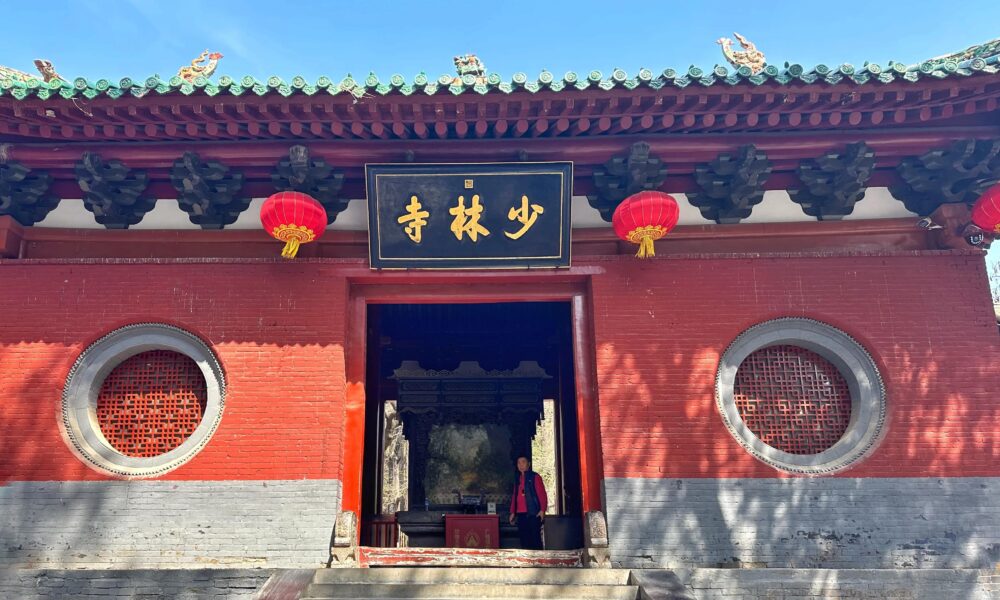I. Introduction
I felt a hard pat on my back. Reluctantly, I opened my bleary eyes. It was still dark outside, a few stars hanging lazily on the night sky. Slowly turning my back, I found the source of my disorientation. It was my mother, urgently calling me to wake up. She handed me some bright orange clothing and two black-and-white, striped leggings. They felt artificial, factory-made, I thought. I hurriedly slipped into the clothes, and glanced at the clock. 5 a.m., it read. I was confused. Why did I wake up at 5 o’clock? I heard my mother’s hurried call again. Looking back at my white bed in the dormitory a final time, with a heavy heart, I stepped out of the door and ran swiftly towards the main temple.
The path was inclined and steep. But when one climbs up the flight of stairs, the Shaolin Temple begins to show its full form. The dark bronze statue of the Xuanwu, a mythical turtle-snake considered divine in China, symbolizes long-life and balance. As I put my palm on its head, a tradition of good luck and longevity, I felt a sense of tranquility, of the constancy of time, and a deep sense of humility. Climbing up the stairs, I couldn’t help but gawk at the marvelous and majestic building. It was a gold and red color, embellished with purple and blue. There were dragons and other mythical animals ornamenting the roof. Walking up the stairs on the side and taking a glimpse of the bright red wall awakened my dreary self.
I silently entered the main hall. In it, the monks were already standing in rows, unmoving like a mountain range. They seemed to have been standing there for an eternity already, blending and mingling into the dark yet consoling temple. Then, they slowly opened their mouths, chanting something exotic, different, yet so…harmonious. It was a choir, evolving from a chant and turning slowly into something musical and melodious. I felt myself sink into the sound. It was like a warm shower, but instead of the physical comfort, it reached into the minds, the hearts, and the souls of everyone around.
II. Chinese Buddhism
Chinese Buddhism is a variant of Buddhism regionalized for China.1 It diverges from the vast belief system known as Buddhism, which originated in the northern plains of India. From the Mogao Caves in the deserts of dry Northwest China, to the Chinese communities overseas spread wide across the world, Chinese Buddhism is not only a religion cherished and celebrated by Chinese people worldwide, it is also a symbol of culture that builds connections between space and time.
Chinese Buddhism has core ideas, beliefs, and concepts that originate from India and maintain its relevance to Buddhism as a whole. One essential concept is the value of all life2, both animal and human, as Buddhists believe that one should not harm animals, which could be human beings returned from a past life in the never-ending cycle of reincarnation. Reincarnation3 is part of the cycle of Suffering and Rebirth. Buddhists believe that what one does in their past lives directly impacts their current life. Through the system of Karma4, good will bring good, and bad will bring bad. For example, if one sins during a past life as a human, he can be reincarnated as a rat in their current life, while if he was charitable and philanthropic, he might be reborn as an angel. Through this process of suffering and rebirth, the Buddha teaches that everything living will die, and every creation will eventually crumble5. The Buddha preaches that one “lives in the moment,” since the cycle of life, death, and rebirth is unstoppable6. The only thing that one should focus on is to try to do as many good things in this life as possible.7
To honor all of these ideas, and to try to become a better life-form when the next cycle of reincarnation comes, practitioners of Chinese Buddhism often engage in unique rituals and practices. In order to honor the lives shared between animal and human, Buddhists condemn the consumption of any meat or animal-related products, such as milk and eggs, which they believe is just as bad as murder or cannibalism, since these animals may as well be one’s family, friends, and children reincarnated from a past life.8
Buddhists also have several ways of achieving presence, or “being in the moment.” Firstly, they participate in the act of meditation. In Chinese Buddhism, rather than focusing on the “One,” for the mind to become one-pointed and focused on one thing, for example, the sound of rain or wind, the goal is different. In Chinese Buddhist meditation, one diffuses the mind and sinks it into the surrounding environment, to meditate the void.9 As the Ming Taoist saint describes:
“Sit quietly in deep meditation and focus on the void. Let chi (cosmic energy) flow round the “small universe” (a continuous flow of energy round the body along the two most important front and back meridians). Build a pearl of chi at the Field of Elixir (vital area of energy focus) at the abdomen. Strengthen and enlarge the chi, and let it permeate the whole body. Gradually direct the pearl of chi to the Heavenly Gate at the crown of the head. Open the crown aperture and let the immortal soul emerge.”10
A final way that the Buddhist becomes one with the moment is by practicing holy scriptures and chants, often in the form of choirs and songs. For example, one of the most famous Buddhist scriptures, the Dabei Chant, is usually performed by a choir of monks, both men and women.11 The chant itself is mesmerizing, and harmonizes with the environment around it, with similar effects as meditation. This form of chanting allows the monks to focus on the soul and the environment, helping them reach the level of the Buddha and release their inner Buddha, reaching Nirvana, or enlightenment.12
III. The Origins of Buddhism in India – the Spread of Buddhism into China – and the Commercialization of Buddhism
Buddhism originated in India, where its central figure was the Buddha, the most important source of its religious teachings. The Buddha, a prince named Siddhartha Gautama, was born in the northern plains of the Indus River Valley. A legend states that, from a young age, several Hindu priests predicted that the prince was going to attain enlightenment, or Nirvana. While he lived in his palace with an unlimited amount of riches and luxury, he often felt bored, so he wandered out of the castle gates. While he was outside the castle gates, he saw all of the sickness, pain, sorrow, and suffering, and he decided to try to find a way to end it. While traveling, he tried to first embrace frugality, before deciding that it only led to more suffering. Sitting down under a Bodhi tree for three days and three nights, he finally gained enlightenment.14 As he began traveling, he taught ten key disciples his doctrine and teachings, allowing them to gain Nirvana too. The Buddha’s original ten key disciples spread the religion into other regions, teaching the ill, the poor, and the unfortunate a way to gain enlightenment – or Nirvana – themselves.15
Among those ten disciples, a few were particularly notable. Firstly, there was Sariputra, otherwise known as Upatissa, who attained Nirvana and was the Great Dharma Teacher, teaching and spreading Buddhism in Indiaalong with Katyayana, who played a similar role in communicating the Buddha’s ideas. There was also Purna Maitrayani, or Putra, who preached the law and “spread the seeds of Buddhism,” teaching students and spreading the doctrines and ideals of Buddhism all across India.16
Another great factor in Buddhism’s worldwide spread was the Silk Road, the trade route between China and Europe (mainly Rome at the time). The term “Silk Road” was coined by German geographer and traveler Ferdinand von Richthofen, to describe the route that spanned the entire continent of Asia, from the capital of China, Chang’an or Luoyang depending on the time period, through central Asia and Anatolia, and all the way to Rome. Through trading and nomadic communities along the Silk Road in Xinjiang or Xizang (Sinkiang or Tibet), Buddhism primarily spread from India to China.17 Further travels of senior monks from India to China deepened this connection, helping build a base for the spread of Buddhism. After the adoption of Buddhism by some communities in China, Chinese Buddhists built the Shaolin Temple, intended to house a foreign, Indian monk.18
Over centuries, Buddhism has gained a great number of followers in China, leading to its eventual commercialization.19 Commercialization is the act of becoming more and more focused on financial profit by extending services, providing new products, or marketing. In this case, the product is Buddhism itself. When they were first established, Buddhist temples did not need to pay taxes. They directly owned their land, and most of the expenses were paid for by the government. This arrangement was justified because Buddhism was an important cultural and religious symbol and the priority of China’s emperors, who were themselves Buddhist. The monks could keep all of the sacrificial funds they received, since they were “for the gods.”20
In later dynasties, with growing devotion to Buddhism, many more temples were built.21 Buddhist temples began to offer customizable personal services. For example: if one paid or donated a certain amount of money, one could build a grave inside the temple as a blessing to more easily go to heaven after death.22 Efforts to reduce the number of temples have been tried by many emperors, such as putting monks in a centralized temple in the capital, but these efforts did not work, since there were ways to get around the rules, such as refusing to record one’s existence as a monk in the system.23
In the 1960s, the Cultural Revolution devastated these temples and brought their future existence into question, forcibly eradicating and eliminating them because of the country’s attempt to secularize and destroy “unrevolutionary thought,” such as religion.24 In later eras, temples were rebranded into a tourist destination and a recreational experience, hosting annual summer camps and spreading internationally.25 The monks of the Shaolin Temple, for example, performed overseas to raise funds, due to the costs of preservation and reconstruction, which were only partially being paid by the government.26
IV. How Chinese Buddhism Connects With Shaolin Culture
One of the most prominent and impactful iterations and expressions of Chinese Buddhism is Shaolin culture. Shaolin has left not only an important cultural and historical impact on China, but also a physical and technical expertise that heavily influences Chinese Kungfu and the Chinese people’s view on martial arts as a whole.27 Shaolin culture is one of the most famous subdivisions of Chinese Buddhism, not only focusing on spirituality and the theory of Buddhism and its scriptures, but also the martial arts and physical moves as expressions of those theories. This combination of elements was, and still remains, essential to Shaolin’s core values.28 The Shaolin branch of martial arts manifests a ferocious and burning energy, in contrast to its serene and tranquil setting in the temple, similar to the idyllic and fairytale-like landscape, the Song Mountain, where it is located. While these aspects of the Shaolin Temple may seem in conflict and contradictory, they merge and complement each other to form a uniquely Chinese identity, expressing the essence and one of the main symbols of Chinese Culture: the Ying and the Yang. While opposites, they bring the Shaolin Culture to life.29
The Shaolin Temple was formed when Indian monk Batuo, or Buddhabhadra, traveled to China. Sponsored by Liang Wudi, the emperor of China of the time and a devout Buddhist practitioner, he founded the aptly named Shaolin Temple on the Shaolin Peak on the Song Mountain.30 The reason Shaolin Peak was chosen was its connection to both heaven and earth, as the highest point of the mountain. Even to this day, the mountain is a center for religious devotion and practice by the three main Chinese belief systems: Buddhism, Taoism, and Confucianism. Started over 1,500 years ago, it was built and expanded over nine dynasties, and continues to survive to this day, serving throughout history as a safe haven for people, especially the destitute, to escape natural disasters, wars, and conflicts on the war-prone land that is China.31
The impact of Shaolin Temple has spread internationally.32 There are now many branches of Shaolin Temple in Europe and America, including those in the United Kingdom, especially the Island of Britain itself, Poland, and Australia. The spread of Shaolin Temples worldwide has also helped spread the popularity of Chinese Buddhism, as more and more people recognize the temple.
V. Conclusion
When I left the temple after prayers, I felt… tranquil. I could barely remember how frustrated I was when waking up at 5 o’clock, like a faint mist dissipating into the sky. Now, I left at peace, my mind blank, fusing and intermingling with the surroundings. I walked out of the temple slowly and steadily, ready to enjoy the breakfast that they serve.
In the breakfast hall, there was silence. One could hear a pin drop. Everybody quietly sat on their benches, not making any noise. The monks began to chant as the younger ones brought huge tubs of food near the tables, distributing it to the people. It was simple: boiled vegetable soup with a portion of steamed buns which are purely made of flour and water. It was filling yet plain, like a monk’s life, sitting and chanting for years, decades, and centuries, as they had always been. As they always will.
For the rest of the day, I practiced martial arts. I first became interested in the warrior aspects of Shaolin when I was young, about five to six years old, reading martial arts novels. Now, I was doing it myself. Shaolin martial arts connect the physical and the spiritual, using Buddhist theories and practicing them physically, making it tangible in the way the aggressive and strong energy is expressed in the body.
By the end of the day, I was exhausted. But I had stepped one foot in the door of Buddhism. I learned about discipline, and how to focus and dissipate my thoughts. And I left Shaolin Temple as if I was a completely different person, prepared for whatever was to come my way.







